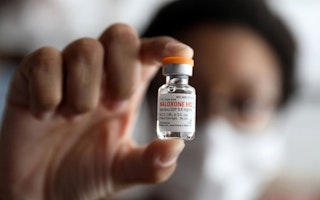President Obama and #DrugPolicyReform: A Leap in the Right Direction
By Whitney Englander
On April 24, the Obama Administration released its 2013 National Drug Control Strategy—and it contains some huge gains for harm reduction advocates.
An annual document that outlines the vision for the Administration’s drug policy, this year’s strategy has replaced emotional “war on drugs” rhetoric with appeals to “evidence,” “science,” and “public health.” The strategy includes unequivocal support for access to methadone and buprenorphine for the treatment of addiction to heroin and other opioids, layperson access to the lifesaving medication naloxone, and a recommendation—complete with call to action—about lifting the federal ban on funding for syringe exchange services.
These three key elements—treatment, overdose prevention, and the benefits of needle/syringe programs—are reinforced throughout the document.
The preface to the strategy, written by Office of National Drug Control Policy Director, Gil Kerlikowske, highlights the story of Project Lazarus, an overdose prevention program in North Carolina that offers community and physician training and naloxone distribution to help prevent fatal overdoses. The strategy goes on to declare overdose prevention a priority for the Administration. It not only recommends that police, firefighters, and other “first responders” carry naloxone, but also recognizes the trained layperson’s essential role in responding to overdoses in the community. The Administration also highlights the potential for Good Samaritan Laws that protect bystanders who use naloxone or call emergency services to save lives in the event of an overdose.
In addition, this official federal document has language that clearly states the Administration’s support for one of the core harm reduction services: needle and syringe programs. Multiple studies, including a notice from the Surgeon General commissioned by the Obama administration, show that syringe services programs can prevent HIV and provide a bridge to addiction treatment. The strategy notes that such programs should be supported with funds for Substance Abuse Prevention and Treatment. Congress, unfortunately, still imposes the federal funding ban on needle exchange.
Support for medication-assisted addiction treatment—and crucially, the need for reimbursement—is highlighted throughout the document. The document also highlights the expectation that the Department of Defense will reverse the long-standing ban on methadone and buprenorphine maintenance treatment. This is good news for America’s military, and sends the right message for those who’ve served the country, but haven’t yet been well served if they have drug dependence problems.
My organization, the Harm Reduction Coalition, believes that harm reduction is about much more than just a series of interventions such as naloxone distribution and syringe services. It is also about promoting social justice by eliminating disparities in health access for drug users, and ensuring that active drug users aren’t deprived of rights or social participation. It would be an overstatement to declare that this strategy accomplishes that goal, but it is a leap in the right direction.
The harm reduction community has come a long way in the past few years in terms of our work with elected representatives and local officials. The Office of National Drug Control Policy has come a long way, too. This year, we have a national drug strategy that proves it.
Whitney Englander is the government relations manager at the Harm Reduction Coalition.

